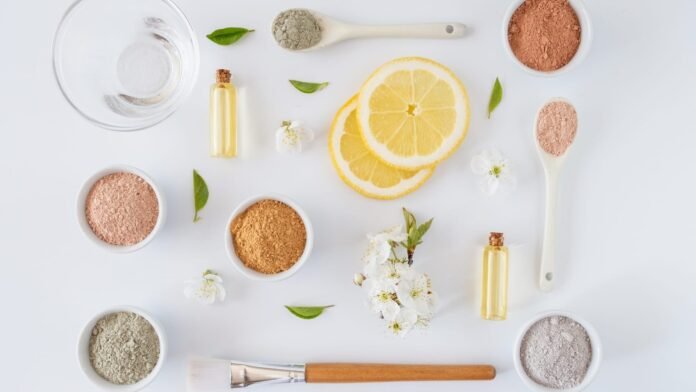While the world of skincare may initially seem like a maze of unfamiliar terms, rest assured that with a bit of guidance, you’ll soon find your way. For skincare beginners, the task of deciphering all these labels and ingredients can appear challenging, but it’s a journey we can navigate together.
But don’t worry; I’m here to guide you through some of the most popular skincare ingredients and what they do.
So, let’s take a proactive approach to learning about skincare. Grab your notepad, get ready to take notes, and let’s dive into the world of skincare ingredients!
Understanding the basics of skincare ingredients will equip you with the knowledge to make informed choices about your skincare routine. Before we dive into the specific ingredients, it’s essential to know some basic skincare terms.
First, let’s discuss active and inactive ingredients. Active ingredients are those that directly benefit the skin, such as improving skin texture or reducing wrinkles.
Inactive ingredients, on the other hand, are often used as fillers or preservatives to enhance the overall product formulation.
Then, there are natural ingredients and synthetic ingredients. Natural ingredients come from plants or minerals, while synthetic ingredients are made in a laboratory.
While both have benefits, it’s important to note that just because an ingredient is natural, it doesn’t necessarily mean it’s better for your skin.
Finally, patch testing is an important step when using new skin care products in daily life. It involves applying a small amount of the product to a small skin area and monitoring for adverse reactions over 24 hours.

Skin care product category
Most skin care products can be divided into four categories: cleansers, toners, moisturizers, and serums. Each category has a specific purpose and can contain a variety of active and inactive ingredients.
cleanser
Cleansers are the first step in any skincare routine; their main job is removing dirt, oil, and impurities from the skin.
Common active ingredients in facial cleansers include salicylic acid for acne-prone skin, glycolic acid for exfoliation, and hyaluronic acid for hydration.
toner
Toners are often misunderstood as unnecessary or too harsh on the skin. In fact, they balance the skin’s pH in preparation for better absorption of other skin care products.
Active ingredients in toners include calming and soothing witch hazel or brightening vitamin C.
Moisturizing cream
Moisturizers are essential for keeping skin hydrated and protected. They come in many forms, such as creams, lotions, and essential oils.
Active moisturizer ingredients range from ceramides that strengthen the skin barrier to peptides with anti-aging effects.
Serum
Serums are highly concentrated products that target specific skin problems, such as fine lines, dark spots, or acne. They often contain higher concentrations of active ingredients than other skin care products.
Common active ingredients found in serum include anti-aging retinol, whitening vitamin C, and niacinamide for overall skin health.
Common skincare ingredients
Now that our compass is pointing in the right direction, we’ll explore some common ingredients you might encounter on your skincare journey.
Vitamin C
Vitamin C, also known as ascorbic acid, is a powerful antioxidant with many benefits. It can help lighten skin tone, provide light protection, and significantly reduce signs of aging, especially in serums used in the morning.
- How to use: Apply a few drops to clear the skin before moisturizing.
- Note: Some people may experience mild irritation, especially those with sensitive skin. Start with a lower concentration and gradually increase it to avoid adverse reactions.
retinol
Retinol is a vitamin A derivative known for its anti-aging abilities. It promotes cell renewal and stimulates collagen production, which reduces the appearance of fine lines and wrinkles. It can also help with acne and hyperpigmentation.
- How to use: Start with a small pea-sized amount every few nights, gradually increasing as your skin gets used to it. Always apply at night and then with a moisturizer.
- Warning: Retinol can cause sensitivity and redness, so start slowly and always wear sunscreen during the day.
Alpha-hydroxy acid (AHA)
Hydroxy acids are water-soluble acids made from sugary fruits. They help peel away the skin’s surface so that new, more uniform skin cells can be created and replaced.
- Glycolic acid: Extracted from sucrose, it is often used to improve skin texture and reduce signs of aging. More experienced users may choose higher concentrations.
- Lactic acid: This mild AHA from milk can also enhance the texture and hydration levels of the skin while addressing dark spots and fine lines.
- Warning: Fruit acids can increase sensitivity to sunlight; be sure to incorporate them slowly into your daily routine to avoid any irritation.
Alpha-hydroxy acid (BHA)
BHA, or salicylic acid, is a gentle exfoliator that helps improve skin texture and unclog pores. It is especially beneficial for those with breakouts or oily skin.
How to use it: Incorporate it into your evening routine and watch for areas of blackheads and blemishes. The next day, use sunscreen, as BHA increases sensitivity to the sun.
Hyaluronic acid
As a humectant, hyaluronic acid can hold up to 1,000 times its weight in water, making it the driving force of hydration. It attracts moisture from the skin’s surface, keeping it plump and moist.
- How to use: Apply to damp skin, then seal with moisturizer. It can be used in the morning and evening.
- Warning: In dry climates, hyaluronic acid can have the opposite effect and absorb moisture from the skin. Use it in a humid environment or seal it with moisturizer.
Niacinamide (vitamin B3)
This multitasking helps to balance the skin, reduce the appearance of pores, even out skin tone, and strengthen the skin barrier.
How to use: It is versatile and can be used in the morning and evening. It is also mild enough to be used with other active ingredients.
Benzoyl peroxide
This ingredient is found in many acne treatments because it kills bacteria in the skin and pores.
- How to use: To avoid drying, start with a lower ratio and gradually increase if necessary. Be sure to apply moisturizer and sunscreen afterward.
- Warning: It bleaches fabric, so be careful when using it near clothing or bedding.
glycerin
Glycerin is a naturally occurring moisturizer that draws moisture into the skin. It is a common ingredient in many skin care products.
How to use: Apply to damp skin, then seal with moisturizer
Dimethylpolysiloxane
Dimethylsiloxane is a silicon-based polymer used to condition the skin and protect the outer layer, giving you that “silky” feel when it comes to skincare.
This is the second most common ingredient in moisturizers and certain cosmetics.
Warning: Some people may clog or irritate pores due to this ingredient, so it’s best to do a patch test before incorporating it into your daily routine.
Copper peptide
Copper peptide is a molecule that occurs naturally in the body and AIDS. It is involved in many functions, including wound healing and tissue repair. In skin care products, it is often used for anti-aging because it promotes collagen production, which helps improve skin elasticity.
How to use: Look for serums or moisturizers that contain copper peptides for best results.
Warning: This ingredient may irritate or cause redness in some people, so it’s best to patch-test it before incorporating it into your daily routine.
Aloe vera essence
Aloe vera is known for its soothing properties. It can calm allergic skin and has a moisturizing effect. It is also rich in antioxidants, which are an important ingredient in anti-aging.
Usage: Apply locally as required. It can also be used as a natural makeup remover.
Green tea extract
Green tea is rich in antioxidants and anti-inflammatory properties, making it a popular ingredient in skin care products. It can help reduce redness, promote collagen production, and protect the skin from environmental stress.
Avoid skincare ingredients
While many ingredients have significant efficacy, there are some that you may need to be aware of, especially if you have sensitive skin.
These ingredients include:
sulfate
Sodium dodecyl sulfate and sodium dodecyl sulfate are common in face washes. They can flake on dehydrated skin.
Silica gel
While harmless to most people, some users find that they can get a little clogged, which, over time, can lead to blockage.
Phthalates
These are used to help skincare products penetrate and are part of the “fragrance” family. As endocrine disruptors, they can be potentially harmful.
alcohol
Not all alcohol is the same, but some can dry out the skin and cause irritation. Look for fatty alcohols, such as cetyl or stearyl alcohol, rather than denatured alcohols, such as ethyl and phenyl.
Benzoates
Parabens are preservatives, but some people may be sensitive or cautious about them due to their potential association with certain health risks. However, the FDA considers it safe to use low levels of parabens in cosmetics.
Mineral oil
While harmless, it can cause congestion in certain thick creams or skin care products, especially for acne-prone skin. Choosing a lighter oil, such as jojoba oil or squalane, is best.

How do you fit into your daily life?
Using a product is just as important as the product you use.
Morning and evening usage
The morning routine is often about protection and hydration. Apply an antioxidant-rich formula and a trusted SPF. The evening is when you can rejuvenate with retinoids and hydroxy acids.
Related: Morning and Evening Skincare Routine: A Comprehensive Guide
Layering techniques
A good rule of thumb is to layer the product from thinnest to thickest consistency. This will allow your skin to absorb each ingredient without any hindrance effectively.
Choose the right skincare products
Making informed decisions about skin care products is as important as the ingredients in your daily life.
Read the label
Reading labels is essential to decipher what product is suitable for your skin. The higher an ingredient is on the list, the more it will be contained in the product.
Skin type precautions
Not all ingredients are suitable for every skin type. Oily, dry, mature, or acne-prone skin all have different needs. Knowing your skin type can guide you in choosing ingredients.





